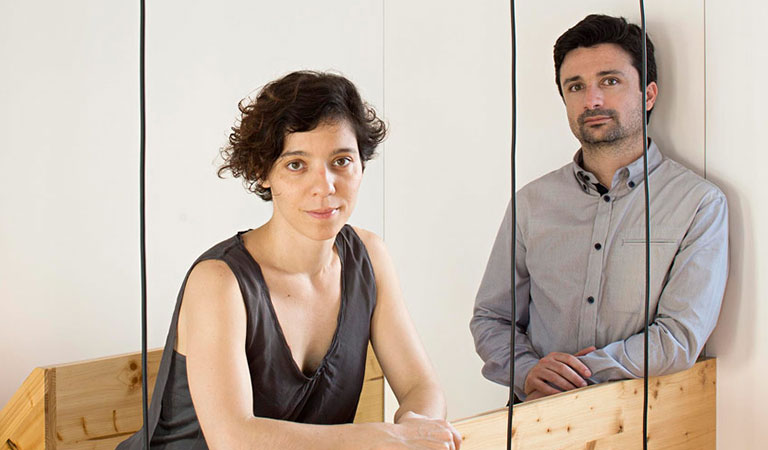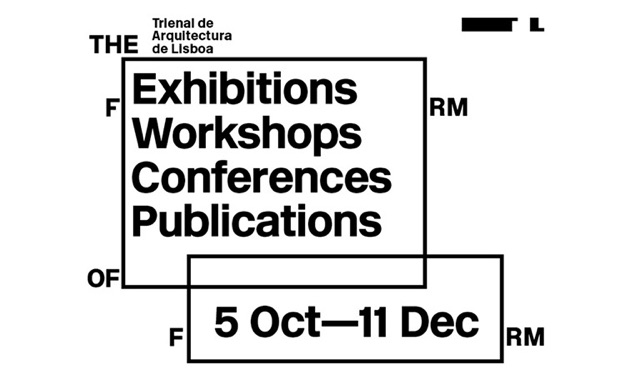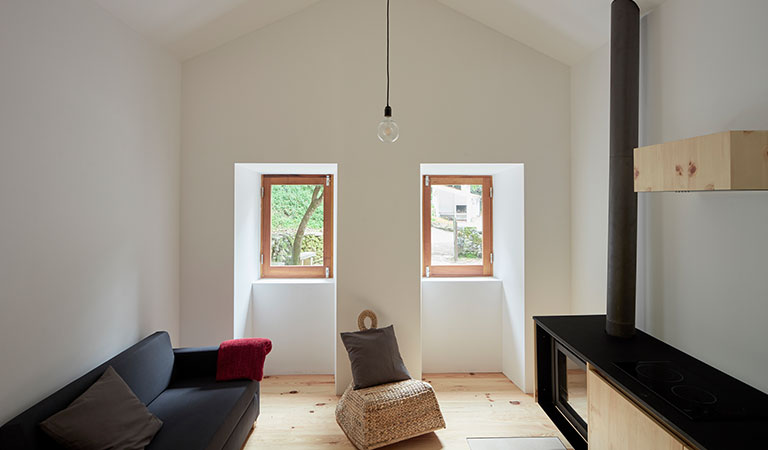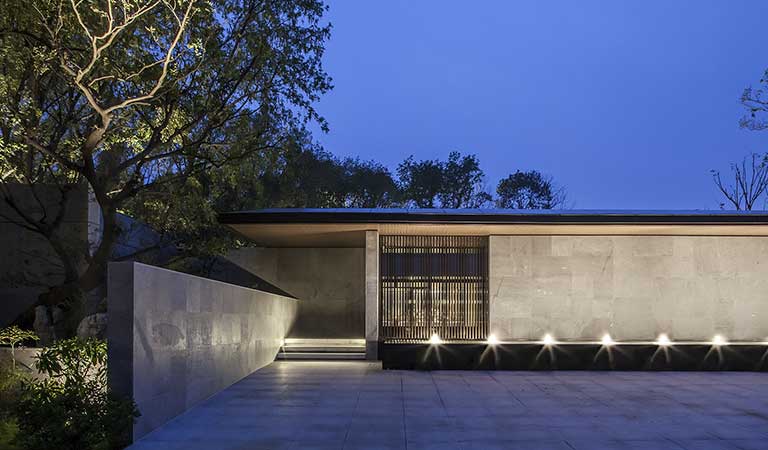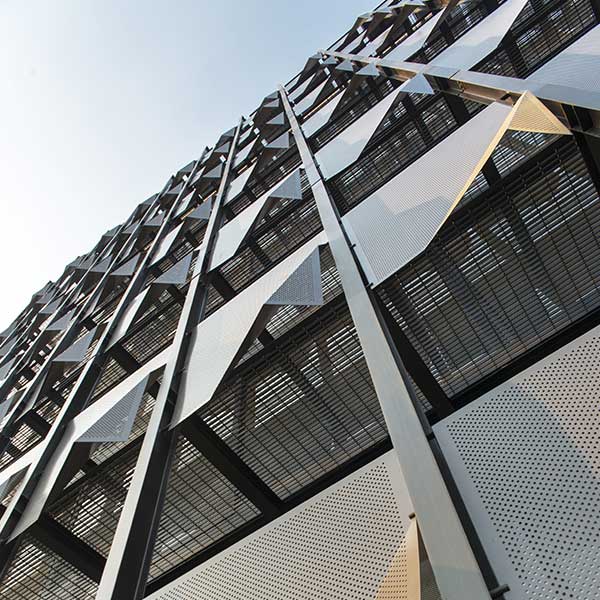Taking on each project as an investigation in itself, challenging its limits and seeking to go beyond, Aires Mateus Arquitectos is today one of the most vibrant offices in Lisbon.
We talked with Manuel Aires Mateus about their work and their view on the current status of architecture in Portugal.
Partindo de cada projecto como uma nova investigação, desafiando os seus limites e procurando ir além, Aires Mateus Arquitectos é hoje um dos escritórios mais vibrantes em Lisboa.
Conversámos com Manuel Aires Mateus sobre o seu trabalho e sobre a práctica de arquitectura em Portugal actualmente.

Manuel Aires Mateus
— START a Project —
What’s the beginning of a project? It's the problem, it's to really assemble the question.
Because a project is always driven by a need for transformation, there’s no project without a need for transformation, even if it’s very generic, even if it’s to think of a zone, to propose a new use, whatever, even if it’s not the classic thing like a program, a place. There’s always a need for transformation or an idea of need for transformation, so there’s a question that becomes generic.
In this question, in this same generic condition we begin to find all realms of reality, which are the place, the possibilities, directions required for the project, things that deep down, inform the question, in a first point of view.
O que é o início de um projeto? É o problema, é a montagem verdadeiramente da pergunta.
Porque um projeto despoleta-se sempre por uma necessidade de transformação, não há projeto sem uma necessidade de transformação, mesmo que ela seja muito genérica, mesmo que ela seja pensar numa zona, repropôr uma nova utilização, seja qual for, mesmo que não seja a coisa clássica que é um programa, um lugar. Há sempre uma necessidade de transformação ou uma ideia de necessidade de transformação, portanto há uma pergunta que se torna genérica.
Nessa pergunta, nessa mesma condição genérica começamos a encontrar todos os domínios da realidade, que são o lugar, as possibilidades, direcções requeridas para o projeto, coisas que no fundo, no fundo, na prática informem a pergunta, num primeiro ponto de vista.

Cantonal Museum of Photography and Museum of Design and Contemporary Applied Arts © Aires Mateus Arquitectos

Cantonal Museum of Photography and Museum of Design and Contemporary Applied Arts © Aires Mateus Arquitectos
Then we start working on this question, what is this? Manage programs, figure out ways to approach them, perceive sites, perceive legality, perceive all the issues that are there. And we begin to turn this question into a more specific question, we go from a generic question to a much more specific question when we actually adjust the question. So deep down we start by working on this generic condition to end up finding a specific condition, because it’s obvious that, there’s also a part of this work that’s about collecting our interests in relation to the project.
And then we keep working on this question. And our idea is that a project really starts by this work on the question, so that the question or this work on the question, ends up leading us to an answer that is more or less evident, I mean, as precise that it becomes evident.
Depois começamos a trabalhar nessa pergunta, o que é que isto é? Gerir programas, imaginar maneiras de os abordar, perceber os sítios, perceber a legalidade, perceber todas as questões que ali estão. E começamos a transformar essa pergunta numa pergunta mais específica, passamos de uma pergunta genérica para uma pergunta muito mais específica quando na verdade acertamos a pergunta. Portanto nós no fundo, começando por trabalhar nessa condição genérica acabamos por encontrar uma condição especifica, porque é evidente que, há também uma parte deste trabalho que é uma parte da recolha dos nossos interesses em relação ao projeto.
E depois vamos trabalhando nesta pergunta. E a nossa ideia é que um projeto se inicia verdadeiramente pelo trabalho sobre a pergunta, portanto que a pergunta ou o trabalho sobre a pergunta, acaba por nos levar a uma resposta que seja mais ou menos evidente, ou seja, tão mais precisa que seja evidente.
— Approach —
I have a clear idea about the approach that matters to us in the projects, what we want to keep is an approach that is always from the core for each project, or at least that’s our goal.
I’m aware of one thing, if I work on a project that I master, it doesn’t go well, it has no freshness, it has no soul. I'm not interested in doing things I know how to do, I'm interested in doing things I don’t know how to do, trying things that create problems, and then the job is really to solve those problems. That's what I think is an interesting job.
Eu tenho uma ideia clara sobre a abordagem que nos interessa nos projetos, o que nós queremos manter é uma abordagem sempre desde a raíz para cada projeto, ou pelo menos esse é o nosso objetivo.
Eu tenho consciência de uma coisa, se eu trabalhar num projeto que domine, o projeto não sai bom, não tem frescura, não tem alma. Não me interessa estar a fazer coisas que sei fazer, interessa-me fazer aquelas que não sei fazer, tentar coisas que me metam em problemas e depois o trabalho verdadeiramente é resolver esses problemas. Isso é que eu acho que é um trabalho interessante.

EDP Headquarters
So I am interested in imagining each project as a unique thing, I am interested in looking at each problem, it starts, and what I would always like to imagine is that I start each project as if it was the first one. Obviously I begin with the experience of having done the others, but with the feeling that it could almost be a project made as if it was the first.
Because every project has to be an investigation in itself, it has to in fact, take to the limit the conditions we have. Obviously this is a work... We’re talking about an ambition we’re not talking about a reality, reality is what you achieve within your ambitions, but this, life is like this isn’t it. I really like that phrase "do not be afraid of perfection because you’re not getting there”, and I find it a very liberating phrase of any kind of idea about it. [laughing]
But we’re interested in this idea that any project is an investigation, and in fact I’m sure that a project to truly reach its limit, is necessary to be completely unique in that sense. And also because history tells us a bit about this idea isn’t it, that most of the architects we like were victims of themselves. They ended up being drawn into an idea of being identifiable as a product value. This is a terrifying thing, a person working only as a product value and therefore clinging to a kind of way of doing or an image to sell or... and this terrifies me a lot.
Portanto eu interessa-me imaginar cada projeto como uma coisa única, interessa-me olhar para cada problema, ele começa e o que eu gostaria sempre de imaginar é que eu começo cada projeto como se ele fosse o primeiro. É evidente que começo com a experiência de ter feito os outros, mas com a sensação de que podia ser quase um projeto feito como se fosse o primeiro.
Porque cada projeto tem que ser uma investigação em si própria, tem que se, na verdade, levar ao limite as condições que temos. É evidente que isto é um trabalho…estamos a falar de uma ambição não estamos a falar de uma realidade, a realidade é o que se consegue dentro das ambições, mas isso, a vida é assim não é. Eu gosto imenso daquela frase “ não tenhas medo da perfeição porque não chegas lá”, e eu acho-a uma frase muito libertadora de qualquer tipo de ideia sobre isso. (risos)
Mas interessa-nos essa ideia de que qualquer projeto é uma investigação, e na verdade estou seguro de que um projeto para se atingir verdadeiramente no seu limite é necessário ser completamente único, nesse sentido. E também porque a história conta-nos um pouco esta ideia não é, de que a maior parte dos arquitetos de que nós até gostamos foram vitimas de si próprios. Acabaram por ficar arrastados numa ideia de serem identificáveis como valor de produto. Isto é uma coisa terrorífica, uma pessoa passar a trabalhar como valor de produto e portanto agarrado a uma espécie de maneira de fazer ou imagem para vender ou…e isso aterroriza-me imenso.

EDP Headquarters
— PROCESS —
We normally reproduce reality in several ways because reality is unrepresentable as a whole, so it’s very interesting to reproduce reality in fragments. We often reproduce a plant and it's the same reality as a section, but the plant tells us about one thing and the section about another and we need to hear about both things isn’t it? Anyway we put together material until this reproduction actually starts to help us.
And so we then move forward going through several stages in that direction, we reproduce, we dialogue with this reproduction, we increasingly inform our interests, we begin to incorporate memories, affections, interests for that project. And we go into each stage, trying to get to the end of a stage, to have it truly clear in the sense in which we want to communicate it, to make it truly accurate, and then we normally redo the process to arrive at that precision. Of course, when you try to be precise, you’re always advancing in a fragmented way, and when you do, you have an idea of what you want, but then you have to redo the process to clean it. And so after this, let's say after successive "washes", we get closer to the project.
Representamos normalmente a realidade de várias maneiras porque a realidade é irrepresentável como um todo, portanto é muito interessante representar a realidade em fragmentos. A gente muitas vezes representa uma planta e é a mesma realidade que um corte, mas a planta fala-nos de uma coisa e o corte de outra e nós precisamos de ouvir falar das duas coisas não é?! Enfim vamos montando material até na verdade essa representação começar a ajudar-nos.
E portanto depois vamos avançando por fases nesse sentido, vamos representando, vamos dialogando com essa representação, vamos informando cada vez mais os nossos interesses, vamos começando a incorporar memórias, afectos, interesses para aquele projeto. E vamos em cada fase, tentando chegar ao fim de uma fase, tê-la verdadeiramente clara no sentido em que a queremos comunicar para a tornar verdadeiramente precisa e depois normalmente refazemos novamente o processo para chegar a essa precisão. É evidente que quando a gente tenta precisar vai-se aproximando sempre de um modo fragmentário, e depois quando chega, tem uma ideia do que quer mas depois tem que refazer o processo para o limpar. E portanto depois isto, digamos por “lavagens” sucessivas, vamo-nos aproximando do projeto.
The evolution of the project always entails three types of representation in the process.
We always make small diagrams that control the design so we always know that everything is... we can realize what’s the setting off of a project, but a project takes several years right? And we have to keep these diagrams which are always overlapping in all stages, to ensure that what’s fundamental in the project remains.
Then we usually do a constructive understanding right from the start, which is very important to realize the reality of the project. Because architecture dialogues a lot with reality, and it must dialogue in a very honest way with reality because to leave it aside, to overcome reality it has to know it very well. So we are interested in knowing right away how much it costs, how it’s done and then we begin to see that possibility.
And then we always work in models, usually made in spherovite, with very large scales. And the reason is that we’re not interested in the fetishism for the "little model", and therefore we want to get away from this world of miniature, and at the same time we want to have models that we can actually put our heads in, see the space, feel the space in a clear way.
A evolução do projeto acarreta sempre três tipos de representação no processo.
Nós fazemos sempre uns pequenos diagramas que controlam o projeto para sabermos sempre que tudo o que está…nós podemos perceber o que é que é um arranque de um projeto, mas um projeto são muitos anos não é, e nós temos que ir mantendo esses diagramas que são sempre sobrepostos em todas as fases, para garantir que aquilo que nos é fundamental no projeto se mantém.
Depois normalmente fazemos uma compreensão construtiva logo desde o principio, que é muito importante para perceber a realidade do projeto. Porque a arquitetura dialoga muito com a realidade, e deve dialogar de uma forma muito franca com a realidade porque para a deixar de lado, para a ultrapassar tem que a conhecer muito bem. Portanto a nós interessa-nos logo saber quanto é que custa, como é que se faz, e aí começamos logo a ver essa possibilidade.
E depois trabalhamos sempre em maquetes, normalmente feitas em esferovite, com escalas muito grandes. E a razão disso é que não nos interessa o fetichismo pela “maquetinha”, e portanto nós queremos afastar-nos desse mundo da miniatura, e ao mesmo tempo queremos ter maquetes que possamos na verdade, pôr a cabeça dentro, ver o espaço, enfim sentir o espaço de uma forma clara.
— Clients —
I think clients have a fundamental role, and I really enjoy the role that clients have to play in a project, it's actually very difficult to have a project without an interventive client. I like interventive clients.
I think this makes projects more interesting because it gives them this uniqueness, we’re talking to people, we’re dialoguing, we’re making the project more and more specific, more and more precise, and this dialogue is very enriching.
Now, we can’t confuse the role of dialogue with the client with the intervention of the client in the project, it’s not quite the same thing. The client has to introduce all the inputs and has before any solution to present his objections, what he can’t do is deliver solutions to the objections, that part it’s not his work. So once these areas are limited in a clear way... I really like clients who tell me "I don’t think I'm very happy". Clients have objections that actually lead us to rethink the project, because I believe that’s where the interest of the project really lays on. And I have no doubt that the more I think of a project the better it gets, until it becomes obvious that it's done, right? There's also a moment when it becomes obvious that it's done.
Eu acho que os clientes têm um papel fundamental, e gosto imenso do papel que os clientes têm que exercer num projeto, aliás é muito difícil um projeto sem um cliente interventivo. Eu gosto de clientes interventivos.
Eu acho que isso torna os projetos mais interessantes porque dá-lhes essa condição de unicidade, nós estamos a falar com pessoas, estamos a dialogar, estamos a criar o projeto cada vez mais específico, cada vez mais preciso, e esse diálogo é muito enriquecedor.
Agora, nós não podemos confundir o papel do diálogo com o cliente com a intervenção do cliente no projeto, não é bem a mesma coisa. O cliente tem que introduzir todos os inputs e tem perante qualquer solução de apresentar as suas objeções, o que ele não pode fazer é entregar soluções para as objeções, que essa parte não é o trabalho dele. Portanto uma vez delimitados estes campos de uma forma clara…eu gosto imenso de clientes que me dizem “não sei se estou muito contente”. Os clientes têm objeções que na verdade levam-nos a voltar a pensar no projeto, porque eu acho que aí é que está verdadeiramente o interesse do projeto. E eu não tenho qualquer dúvida de que quanto mais penso num projeto melhor ele fica, até ele se tonar óbvio que está feito não é?! Também há um momento em que se torna óbvio que está feito.

Meeting Centre in Grândola © Aires Mateus Arquitectos
— MATERIAIS —
The material is usually found in the project. I’m asked several times the question "why is everything white?" To which I have to say that things don’t usually start white they end up white, because it turns out to be the hypothesis to do, the way to better answer, the technological hypothesis, and a hypothesis of something that is very important to us, which is a certain idea of mono-materiality.
That is an idea, it’s not a canon, it has nothing of canon, it’s a kind of thing that we also approach in the development of each project. We think very strongly that the projects are very centered on space, about this idea of space, about emptiness, about the idea of usable space, and so often what we want is to not have dialogues, to have only a spatiality. And this sense of spatiality is often more easily given by an idea of something that’s mono-material.
And then the white turns out to be the material that often ends up responding to all the restraints, and it’s the material with which it’s possible to work.
O material normalmente encontra-se no projeto. Fazem imensas vezes a pergunta “porque é que é tudo branco?” Ao que eu tenho que dizer que as coisas normalmente não começam brancas acabam brancas, porque acaba por ser a hipótese de se fazer, a maneira como melhor se responde, a hipótese tecnológica, e uma hipótese de uma coisa que para nós é muito importante, que é uma certa ideia de mono-materialidade.
Que é uma ideia, não é um cânone, não tem nada de cânone, é uma espécie de coisa que a gente também se aproxima no desenvolvimento de cada projeto. Nós achamos que os projetos são muito centrados sobre o espaço, sobre esta ideia de espaço, do vazio, da ideia do espaço utilizável, e portanto muitas vezes o que nós queremos é não ter diálogos, ter só digamos, uma espacialidade. E essa sensação de espacialidade muitas vezes é mais facilmente dada por uma ideia de uma coisa que seja mono-matérica.
E depois o branco acaba por ser muitas vezes o material que acaba por responder a todas as condicionantes, e ser o material com o qual é possível trabalhar.

Houses in the sand © Aires Mateus Arquitectos

Houses in the sand © Aires Mateus Arquitectos
We’ve been doing some buildings with different materials, for example now we’ve made those huts that are totally made of wood, or we’re making a house that is totally made of brick, or we’ve been doing some experiments with concrete, totally made in concrete.
And in fact we were fortunate enough to do in my favorite material that is stone, we were lucky to make a pavilion. So the idea of the pavilion was, it’s a pavilion made of blocks of stone, but blocks with 60 or 70cm wide, stacked, built in the traditional way, with four walls.
And then we came up with this idea, we called it a wall for eternity, because it's actually an indestructible wall, it's a very thick wall with compressed stones, this very beautiful idea of enormous durability. And then this was a fair in Italy, Verona, and we made a natural lawn inside, so the fair lasted for four or five days, and that was exactly the time that the lawn would take to die.
So we had this kind of idea that architecture was eternal unlike nature, so there was a game of relationship with time that interested us in this pavilion.
And this was maybe the time I got to use the material, in the most... maybe one of the materials I like the most, that I like the most culturally, I don’t know if I like it in another way. But culturally for me, I still have as favorite places, or some of my favorite places are those “coluni” churches, all made of stone, there’s that solid side to it, that idea that we have... the floor, the ceiling, the vaults, everything is the same material. This, to me, is wonderful.
Nós temos agora feito alguns edifícios com materiais diferentes, por exemplo fizemos agora aquelas cabanas que são totalmente feitas em madeira, ou estamos a fazer uma casa que é totalmente feita em tijolo, ou fizemos agora uma ou outra experiência em betão, coisas totalmente feitas em betão.
E na verdade tivemos a sorte de fazer naquele que é o meu material de eleição que é a pedra, tivemos a sorte de fazer um pavilhão. Então a ideia do pavilhão foi, é um pavilhão feito em blocos de pedra, mas blocos com 60 ou 70 de largura, empilhados, portanto blocos construídos na maneira tradicional, aquilo são 4 paredes.
E depois acabámos por fazer esta ideia, nós chamámos-lhe um muro para a eternidade, porque na verdade é um muro indestrutível, é um muro espessíssimo com pedras à compressão, essa ideia muito bonita da enorme durabilidade. E depois aquilo era uma feira em Itália, Verona, e nós dentro fizemos um relvado natural, portanto a feira durava 4 ou 5 dias e que era exactamente o tempo que o relvado levava a morrer.
Portanto nós tínhamos uma espécie de ideia de que a arquitetura era eterna ao contrário da natureza, havia ali assim um jogo de relação com o tempo que nos interessou nesse pavilhão.
E essa era assim talvez a vez em que eu consegui utilizar o material, na forma mais… talvez um dos materiais que mais gosto não é, que mais gosto talvez culturalmente, não sei se gosto mais noutro sentido. Mas culturalmente para mim eu continuo a ter como espaços predilectos, ou alguns dos meus espaços predilectos são aquelas igrejas de coluni todas feitas em pedra, há assim aquele lado maciço, aquela ideia que a gente tem…o chão, o tecto, as abóbadas, tudo é o mesmo material. Isso é, para mim, maravilhoso.

Stand Stone Pierre Grassi © Raffaello Galiotto

Stand Stone Pierre Grassi © Raffaello Galiotto
— PORTUGAL —
Architecture here is fantastic, making architecture here is fantastic, the living conditions of the architects are pitiful.
And I say this with the greatest regret, I have the greatest admiration for the young portuguese architecture, a huge admiration. Each time I find more... They surprise me things that I... Are brand new, and the younger they are the more things are surprising. And I realize, and you see in that the hardness that is, to arrive at a time like the one of today, to do things with that quality.
A Arquitetura cá é fantástica, fazer arquitetura cá é fantástico, as condições de vida dos arquitetos são lamentáveis.
E digo isto com a maior pena, tenho a maior admiração pela jovem arquitetura portuguesa, uma admiração enorme. Cada vez encontro mais…me surpreendem coisas que eu…são novíssimos, e quanto mais novos são mais as coisas são surpreendentes. E percebo, e percebe-se naquilo a dureza que é, chegares num tempo como o de hoje, a fazer coisas com aquela qualidade.

Santa Marta Lighthouse Museum

Santa Marta Lighthouse Museum
At the same time this is true, I also know the hardness that drags this whole process, all this difficulty that is to make architecture in Portugal. In fact a lot has been lost, institutionally the respect, in the end it’s also a generic thing, the respect for work has been lost. It was the great problem of the crisis, the loss of respect for work, work not as a value, the values are others work is a thing perhaps necessary but never a value. When, in fact, work is the core value of any production, it’s what really matters.
And in relation to the architects the problem is a bit this, the difficulties are very big, things are very complicated, I say this obviously stressing that, for me they’re not so much but this doesn’t change the conditions at all. That is, conditions globally are very, very difficult.
But we are a country of resistance, we have an architecture teaching that I don’t think is good and we have succeeded with this teaching to produce extraordinary young architects, so here is a paradox also very interesting. We have very difficult conditions to work with and we can produce very good architecture.
Now obviously it's a condition that’s not fair at all, it's not at all fair and I think most people have no idea of the effort it takes to make an architecture project.
Ao mesmo tempo que isto é verdade, também sei a dureza que arrasta todo este processo, toda esta dificuldade que é fazer arquitetura em Portugal. Na verdade tem-se perdido muito, institucionalmente o respeito, enfim é uma coisa também genérica, perdeu-se o respeito pelo trabalho. Foi o grande problema da crise, perdeu-se o respeito pelo trabalho, o trabalho não sendo um valor, os valores são outros o trabalho é uma coisa talvez necessária mas nunca um valor. Quando na verdade o trabalho é o valor central de qualquer produção, é verdadeiramente o que interessa.
E em relação aos arquitetos o problema é um pouco este, as dificuldades são muito grandes, as coisas são muito complicadas, digo isto sempre obviamente com uma ressalva, para mim não são tanto mas isso não altera em nada as condições. Ou seja, as condições globalmente são muito, muito difíceis.
Mas nós somos um país de resistência, nós temos um ensino de arquitetura que eu não acho bom e conseguimos com esse ensino produzir extraordinários jovens arquitetos, portanto há aqui um paradoxo também interessantíssimo. Temos condições muito difíceis de trabalhar e com isso conseguimos produzir muito boa arquitetura.
Agora obviamente é uma condição que não é justa, de todo, não é mesmo justa e eu acho que a maior parte das pessoas não tem a ideia do esforço de um projeto de arquitetura.

Model of the Architecture Faculty in Tournai © Aires Mateus Architectos
